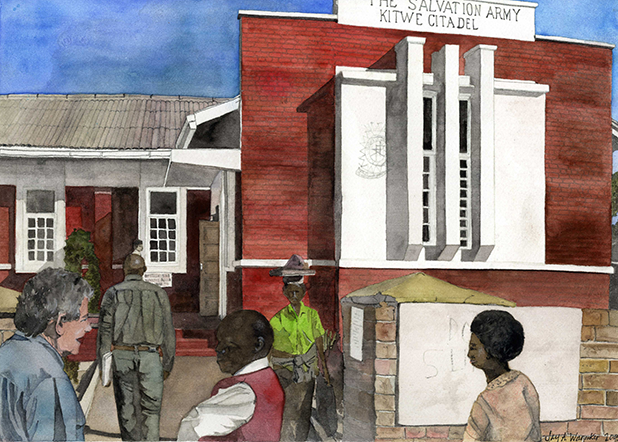 Exterior View (2005), 15” x 11” Watercolor, Jay A. Waronker
Exterior View (2005), 15” x 11” Watercolor, Jay A. Waronker
ZAMBIA
Former Kitwe Hebrew Congregation (Formed in the 1920) Synagogue (Completed in 1946; Building Sold in the 1980s) |
|

Interior View (2005), 15” x 11” Watercolor, Jay A. Waronker
|
It was World War II, and the influx of Jewish refugees which preceded its outbreak, which provided the chief stimulus for the creation of a more sizeable and sustainable Jewish population in Zambia, then known as Northern Rhodesia. With this came the realization of tangible Jewish institutions throughout the country, including synagogues as well as social hall, schools, and cemeteries. Along with Jewish communities in the capital city of Lusaka and at Livingstone to the south, Jews settled throughout the Copperbelt Region in central Zambia. There the discovery and exploitation of the valuable mineral in the first half of the 20th century resulted in an explosion of economic activity. The massive deposits of copper could be said to be the true reason for Zambia’s allure to European imperialism and its overall existence, and Zambian mines came to supply the industrializing world’s demand for this important natural resource. While Jewish involvement in the actual mining industry was limited, Jews quickly set up tangential businesses in this region, particularly in the areas of real estate development, trade, service, and transportation. Many town centers had buildings built by Jews, including offices, shops, hotels, and department stores.
Among the synagogues built in the Copperbelt Region was one in Kitwe, a mid-sized and centrally-positioned regional city with a population of nearly three-quarters of a million people today. The city, for decades the center of Zambia’s mining business, has long been one of the economic centers of the country. While Jewish involvement in the actual copper mining industry was not always direct, Jews focused on other businesses needed for expanding and maintaining the cities in the region. As Zambia’s second largest city and the country’s premier mining city, Kitwe offered the Jews who settled there not only professional opportunities but a decent standard of living. Its compact and pedestrian-friendly town center featured a variety of buildings, including shops, hotels, and department stores. Some of these were in fact developed by Jews.
The buildings constructed as synagogues in Kitwe and the rest of the region, dating from the early 1940s to early 1950s, still stand although none of them still function as Jewish houses of prayer. Beginning in the mid-1960s, following Zambia’s independence from the British and with an uncertain future for white Zambians, the entire Jewish community, with the exception of a mere handful of people, moved from the Copperbelt Region. Once this happened, the synagogues were sold and, albeit still used for religious purposes, are now churches and Christian facilities.
Before Kitwe had a synagogue, the town’s Jews held prayer services in private homes or temporary facilities. When a synagogue was completed in 1946, it was built on a prominent location in the center of town. For some three decades it ably served the small congregation until the community began experiencing dramatic decline. Without enough of the community left to maintain and operate the synagogue, it was sold in the 1970s to the Salvation Army. It has since then been used as their church, community center, and headquarters.
The synagogue as realized was most likely designed by a local non-Jewish white architect without any synagogue or even important civic or ceremonial building design experience. It is a competent yet architecturally unassuming rust-colored brick and precast stone structure that has changed little since it was completed and later transferred over to its current owner. The most prominent change once it became a church was when the new Salvation Army owners removed the carved stone Star of David displayed on the front façade in what was the synagogue’s social hall. When one of the few Jews remaining in the Copperbelt Region, Gus Liebowitz, learned about this, he went to the site, found the broken and abandoned relic lying on the ground, and rescued it by taking it to his home. Since then, this star has remained on display in his living room, preserved as an important historical and cultural marker of the ways things once were in Kitwe. It can be said to represent another transition in the long story of the Jewish diaspora.
The building’s main doors lead into a large room, which originally served as a social and gathering hall. At the time of this painting, it functioned as a vocational training space lined with sewing machines. Here Waronker, the artist of this painting, witnessed women working away on the whirling machines. The adjacent sanctuary was mostly intact, including its original heavy wooden pews, tray ceiling made up of flat panels with batten strips at the joints, double hung windows, painted plaster walls, and pendent lighting fixtures. The bimah, a table centrally-placed in the space and used for reading the Torah, had been removed but was now in storage elsewhere in the building. On the sanctuary’s end wall, the ark, albeit now empty, was still in space with its paneled wooden doors. The ark was set within a niche with a round-arched front that had also not been disturbed.
